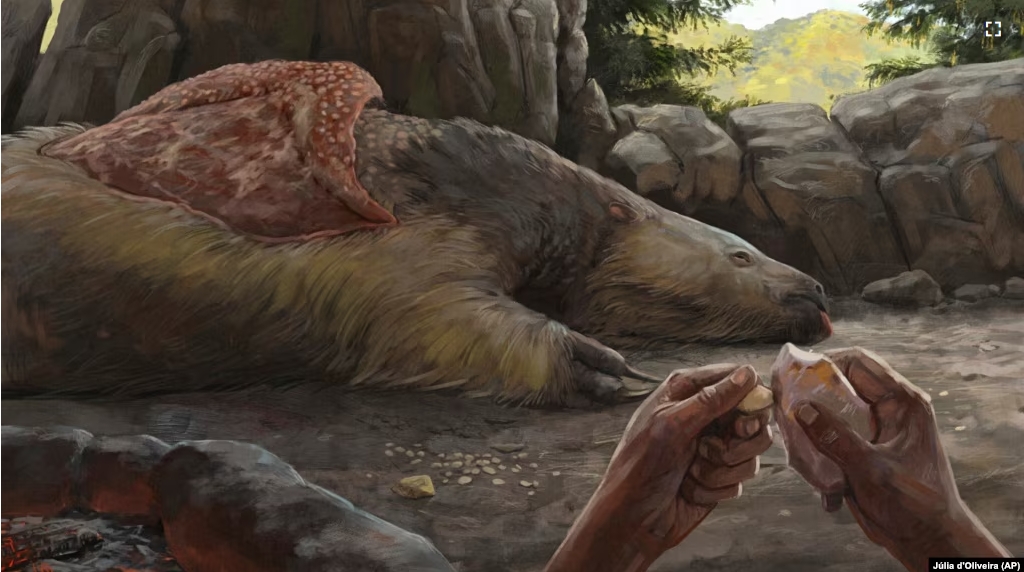A sloth is a furry animal that lives mainly in South and Central America. It moves very slowly and spends most of its time in trees.
But thousands of years ago their ancestors were huge. Giant sloths could weigh up to 3.6 metric tons and lived on the ground.
For many years, scientists believed the first humans to arrive in the Americas quickly killed off these giant ground sloths, along with many other huge animals. Those include mastodons, saber-toothed cats, and dire wolves.
But research in recent years suggests that humans might have arrived in the Americas thousands of years earlier than scientists had once believed. New findings suggest that humans lived with the big animals for thousands of years.

Daniel Odess is an archaeologist at White Sands National Park in the American state of New Mexico.
“There was this idea that humans arrived and killed everything off very quickly — what’s called ‘Pleistocene overkill,’” he said. But new discoveries suggest that “humans were existing alongside these animals for at least 10,000 years, without making them go extinct.”
Santa Elina is a place in central Brazil where archeologists are looking for the remains of ancient animals and humans. There, scientists have found bones of giant sloths. However, the bones look like humans used them and changed them.
Mírian Pacheco is a researcher in a laboratory at the University of São Paulo. Pacheco recently showed The Associated Press a small, round sloth fossil. She noted that the fossil is smooth and there is a very small hole near one edge. She said it looks like humans changed the bone on purpose. She added that researchers think the bone was probably used as jewelry.

The animal bones from Santa Elina are about 27,000 years old. That is older than scientists had thought possible. Some had believed that humans only arrived in the Americas 11,000 years ago.
Researchers at first wondered if humans had been working with ancient fossils. But Pacheco’s research strongly suggests that ancient people were carving “fresh bones” shortly after the animals died.
Pacheco studied chemical changes that take place when a bone becomes a fossil. She said the bone had been carved “before the fossilization process.” Pacheco’s team also ruled out natural processes.
In high school, Pacheco learned that most archeologists believed humans arrived in the Americas about 13,000 to 11,000 years ago. “What I learned in school was that Clovis was first,” she said.
Clovis is a place in New Mexico where archaeologists in the 1920s and 1930s found objects dated to between 11,000 and 13,000 years ago. Until more recent years, Clovis objects, or artifacts, were among the oldest known in the Americas.
Scientists say there was a large decrease in the number of large animals at that time. The period is also believed to mark the end of the last Ice Age: a period when large areas of land were covered with thick ice and snow.

Briana Pobiner is a paleontologist with the Smithsonian Institution’s Human Origins Program. Pobiner said, “It was a nice story for a while, when all the timing lined up,” adding, “But it doesn’t really work so well anymore.”
In the past 30 years, new research methods, including ancient DNA, have suggested a different story.
The first place that most scientists agreed was older than Clovis was Monte Verde, Chile.
There, researchers discovered 14,500-year-old stone tools, pieces of animal skins, and several plants people could eat and use for medicine.
“Monte Verde was a shock,” said Tom Dillehay. He is an archeologist at Vanderbilt University in the American state of Tennessee. Dillehay has carried out research at Monte Verde for many years.

At New Mexico’s White Sands, researchers have uncovered human footprints dated to between 21,000 and 23,000 years ago. The site also has tracks of giant animals dated to about the same time. However, archeologists have not found any artifacts at the site.
Researchers continue to disagree about the timing of humans’ first arrival in the Americas. But if they did arrive earlier than once thought, several scientists now believe that it is possible they did not immediately kill off the giant animals living in the Americas.
I’m Andrew Smith. And I’m Mario Ritter, Jr.
Christina Larson reported this story for The Associated Press. Andrew Smith adapted the story for Learning English.
__________________________________________
Words in This Story
furry –adj. covered with animal hair
Pleistocene –n. a period of time from about 2.5 million to 11,000 years ago
extinct –adj. no longer existing on the Earth
archeologist –n. a person who studies ancient human life
fossil –n. the mineralized remains of a tissue of a living thing
jewelry –n. objects that are worn on the body to beautify and show status
carve –v. to slowly cut away material to make a design or special surface
